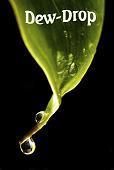LOCATING A FRESH WATER SPRING
Most springs are a good source of clean water. Mother Earth filters and cleans these water flows while they are passing through the ground.
Exceptions:
1) What is above the spring? Any people or livestock areas?
2) Has this area been turned over or developed before?
3) Is there any industry nearby?
Look for "green spots" or "areas of plant and tree growth" in otherwise dry areas. A good situation is a flow of water coming off a hill or mountainside with only trees and vegetation above it.
If you find an area of green plant and tree growth, the next thing to do is to determine what type of plants and trees are growing there. You would like to find cottonwood trees, foxtails, ferns, reeds and other water loving growth. That would mean that there is a strong, relatively deep flow of water.
How to Develop a Fresh Water Spring
Once you have found a promising spot, you must develop it with care to avoid contaminating the water.
First, scrape clear the area, either in a "dip" or where the most "greenery" exists. You want to remove all humus or organic material from the surface of the ground. Take your time and do a good job. Cleaning the surface of the ground is the most important step in order to keep the trapped or captured water clean and pure.
At this point you should be looking at a bare patch of earth that is a minimum of 3 feet in diameter.
Next, using a clean shovel, start digging down in the middle of the cleared area. What you are trying to create is a depression in the clean mineral soil in which water will slowly fill. In essence you are creating a mini pond or pool. Ideally you want to make this "dug out" over size for a variety of reasons.
1) This ground hollow will accumulate and hold more water.
2) The size of the hole allows better natural filtering of the spring water. You are increasing the total surface area to water ratio.
3) Depending on year round conditions; you increase the holding reservoir capacity of the fresh water. This will help provide water in times of draught.
4) Lastly, the depth of the dug hole puts you closer to the source of the spring or underground stream (direct flow).
Now you have some decisions to make. How developed do you want this spring?
Some people have shored up the walls of the dug out hole with large rocks (something I personally believe in). Others have poured a concrete box with an open bottom.
I think that keeping the spring as natural as possible is the way to go. This is all about sharing with nature. Your guard against contamination, while still sharing with animals and plants. By doing this you will create an oasis as well as a water source.
The bottom of the collection hole should be lined with 1 - 2 inch sized washed gravel. Under this bottom lining sand should be used as a final filter. Setting up your water source this way provides filtering and a natural bio filter where the healthy bacteria always present in the ground will react and further purify incoming water.
Before Use
You need to scoop or pump out the spring water hole after it fills. Remove as much water after the hole fills three times. The natural flow of new water will bring in the cleanest water more directly from the spring.
|



